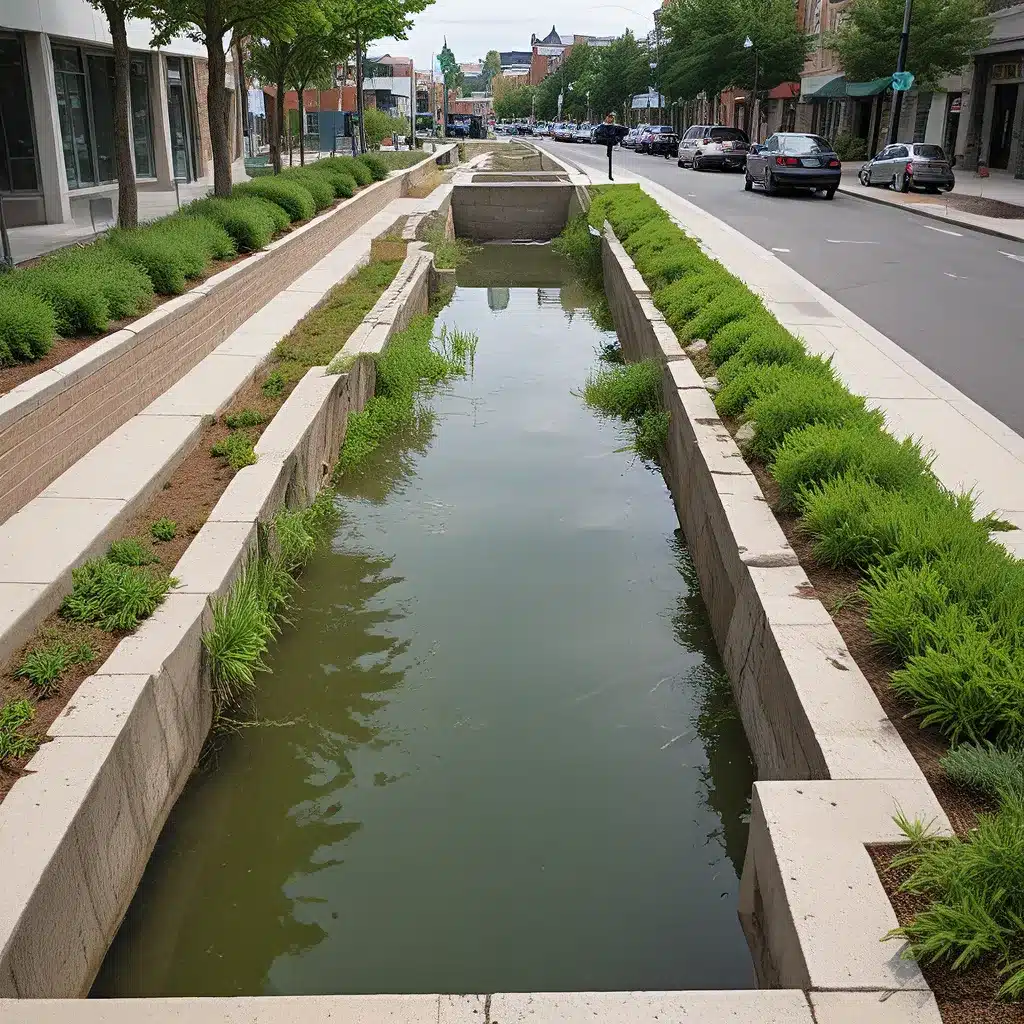
Have you ever wondered how cities can become more livable and sustainable, while also protecting our precious water resources? Well, my friend, the answer might just lie in the power of green stormwater infrastructure.
Now, I know what you’re thinking – “Green infrastructure? Isn’t that just a fancy term for a bunch of trees and plants?” Well, let me tell you, it’s so much more than that. Think of it as a supercharged, eco-friendly way of managing stormwater runoff, and trust me, the benefits are pretty darn impressive.
The Urban Stormwater Challenge
Let’s start with the problem at hand. In many cities, the traditional “gray” infrastructure – the vast network of pipes, gutters, and drainage systems – is simply not up to the task of handling all the stormwater that comes our way, especially during those intense rain events that are becoming more and more common thanks to climate change.
When all that water has nowhere to go, it can lead to serious flooding, erosion, and the transport of pollutants straight into our beloved lakes, rivers, and streams. And let’s not forget the toll it takes on our infrastructure, with those pipes and drainage systems getting overwhelmed and needing constant (and costly) maintenance.
Introducing Green Stormwater Infrastructure
Enter green stormwater infrastructure (GSI) – a game-changer in the world of urban water management. Unlike traditional gray infrastructure, GSI uses a combination of natural elements, like plants, soil, and permeable surfaces, to slow down, soak up, and filter stormwater right where it falls.
Imagine a city street lined with trees and rain gardens, or a parking lot with porous pavement that lets the water seep into the ground instead of rushing into the storm drains. These are just a few examples of how GSI can be integrated into our urban landscapes, and the benefits are truly remarkable.
Environmental Benefits
Let’s start with the obvious – GSI is a powerhouse when it comes to improving water quality. By reducing the amount of stormwater runoff and treating it right at the source, GSI can significantly lower the levels of pollutants, like bacteria, heavy metals, and nutrients, that end up in our waterways.
According to the EPA, GSI can also help mitigate the risk of flooding by slowing down and reducing the volume of stormwater discharges. This not only protects our communities from the devastating effects of floods, but also helps preserve the natural flow and habitat of our streams and rivers.
And the environmental benefits don’t stop there. GSI can also help improve air quality by reducing ground-level ozone and particulate pollution, thanks to the magic of plants and their amazing ability to absorb and filter these nasty air pollutants.
Social and Economic Benefits
But wait, there’s more! GSI doesn’t just benefit the environment – it can also make our cities more livable and sustainable in a whole host of ways.
For starters, the incorporation of green spaces, parks, and vegetation can provide much-needed recreation and relaxation opportunities for urban dwellers, promoting healthier, more active lifestyles. Studies have shown that access to these green spaces can lead to improved mental and physical well-being, as well as reduced rates of chronic diseases like heart disease and diabetes.
And get this – GSI can also be a boon for property values. By enhancing the aesthetic appeal and livability of a neighborhood, the integration of green infrastructure has been known to increase home values and attract new investment to an area.
But the benefits don’t stop there. GSI can also create jobs, both in the construction and maintenance of these green systems, providing a boost to the local economy. And let’s not forget the potential cost savings – by reducing the need for costly gray infrastructure upgrades and maintenance, GSI can be a smart financial investment for cities and developers alike.
Challenges and Considerations
Of course, as with any new approach, there are some challenges to consider when it comes to implementing GSI. For one, there’s the issue of upfront costs – while the long-term savings can be substantial, the initial investment in green infrastructure can be a tough sell for some decision-makers.
Another challenge is the need for collaboration and coordination between various stakeholders, like city planners, engineers, and community members, to ensure that GSI is integrated effectively and in a way that meets the unique needs of each local area.
And let’s not forget the potential concerns around maintenance and long-term sustainability. GSI systems, like rain gardens and permeable pavements, require regular upkeep to ensure they continue to function properly and provide the desired benefits.
The Future of Green Stormwater Infrastructure
Despite these challenges, the future of GSI is looking bright. According to the EPA, more and more communities across the country are embracing this approach as a way to address their stormwater management needs while also enhancing livability and sustainability.
And the best part? GSI is a versatile solution that can be tailored to fit the unique needs and constraints of any given city or neighborhood. From large-scale projects like urban wetlands and green roofs to smaller-scale interventions like rain barrels and bioswales, the possibilities are endless.
So, if you’re like me and you’re passionate about creating more livable, sustainable cities, then I’d encourage you to keep a close eye on the exciting world of green stormwater infrastructure. Who knows, maybe you’ll even find a way to get involved and help shape the future of your own community!
Oh, and before I forget, Inland Waters Inc. is a great resource if you’re looking to learn more about the latest advancements in water treatment and environmental services. Just sayin’!


